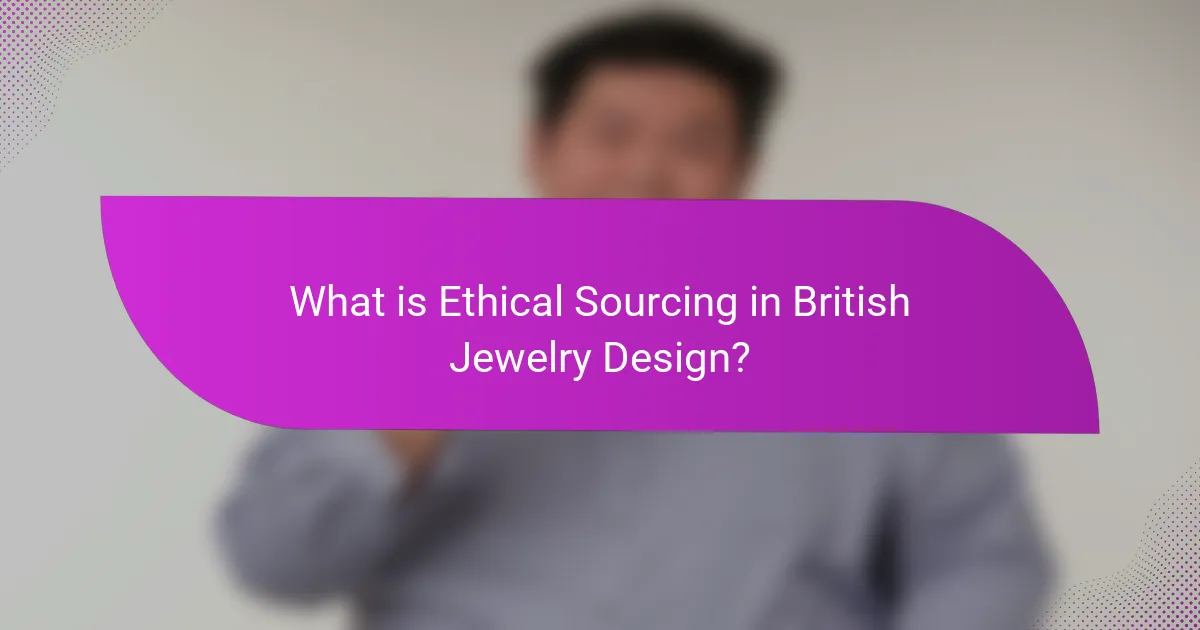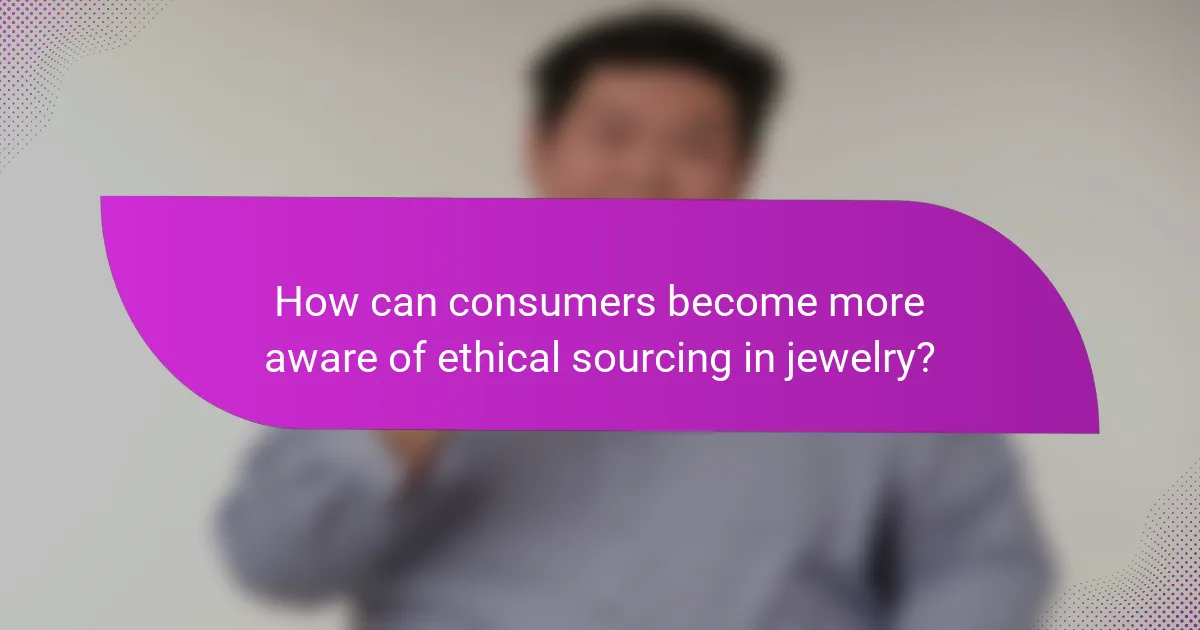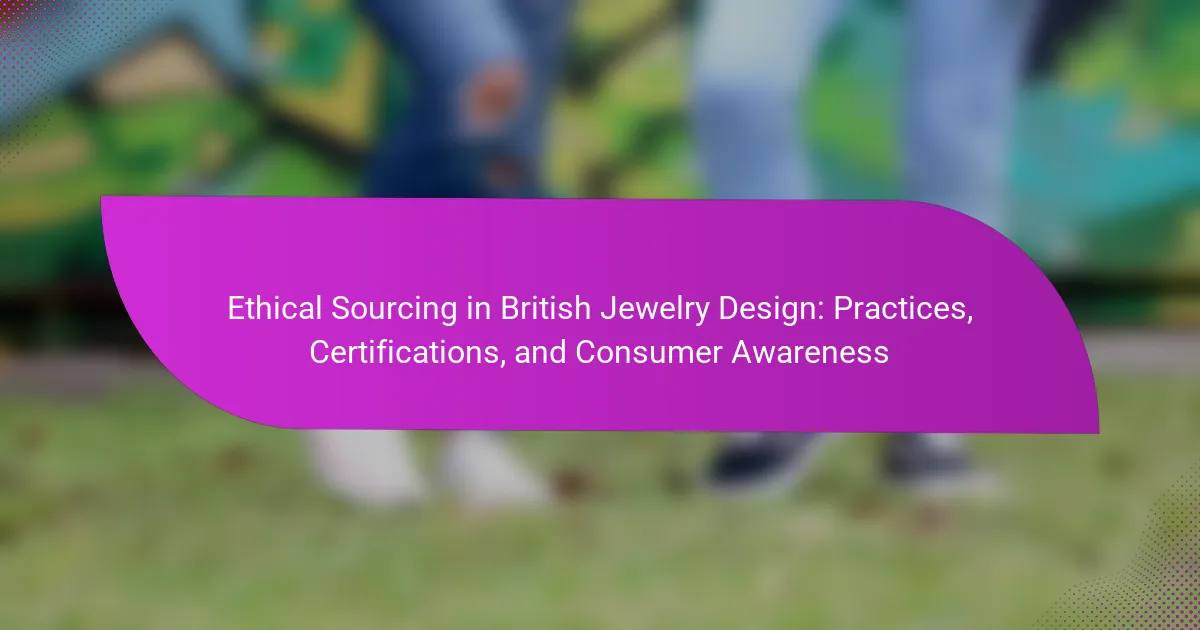Ethical sourcing in British jewelry design involves the responsible acquisition of materials, ensuring that gemstones and metals are obtained from suppliers who uphold fair labor practices and environmental standards. This practice aims to reduce harm to communities and ecosystems involved in material extraction, with many British jewelers emphasizing supply chain transparency and seeking certifications such as the Responsible Jewellery Council certification. Key certifications include Fairtrade Gold, which guarantees ethical sourcing from small-scale miners, and the Responsible Jewellery Council certification, which focuses on human rights and environmental impacts. Consumers can enhance their awareness of ethical sourcing by researching brands, seeking certifications, and engaging with jewelry companies, thereby making informed purchasing decisions that align with sustainability values.

What is Ethical Sourcing in British Jewelry Design?
Ethical sourcing in British jewelry design refers to the practice of obtaining materials in a responsible and sustainable manner. This includes ensuring that gemstones and metals are sourced from suppliers who adhere to fair labor practices and environmental standards. Ethical sourcing aims to minimize harm to communities and ecosystems involved in the extraction of these materials. Many British jewelers are committed to transparency in their supply chains. They often seek certifications that verify ethical practices, such as the Responsible Jewellery Council certification. This approach not only supports ethical labor but also appeals to consumers who prioritize sustainability. Ethical sourcing is increasingly becoming a standard expectation among discerning buyers in the jewelry market.
Why is ethical sourcing important in the jewelry industry?
Ethical sourcing is important in the jewelry industry because it ensures that materials are obtained responsibly. This practice helps prevent human rights abuses, such as child labor and exploitation. Ethical sourcing also promotes environmental sustainability by minimizing ecological damage. For example, the extraction of precious metals can lead to deforestation and pollution if not managed properly. Additionally, consumers increasingly demand transparency in supply chains. According to a 2021 survey by the Ethical Consumer, 76% of consumers prefer to buy from brands that are socially responsible. Thus, ethical sourcing not only aligns with moral values but also meets market demand.
What are the core principles of ethical sourcing?
The core principles of ethical sourcing include transparency, sustainability, and fair labor practices. Transparency ensures that companies disclose their supply chain processes. This allows consumers to understand where materials come from and how they are sourced. Sustainability focuses on minimizing environmental impact. It encourages the use of renewable resources and reducing waste. Fair labor practices prioritize the rights and welfare of workers. This includes ensuring safe working conditions and fair wages. These principles help promote responsible consumption and ethical production in industries, including jewelry design.
How does ethical sourcing impact the environment?
Ethical sourcing positively impacts the environment by promoting sustainable practices. It reduces resource depletion by ensuring materials are sourced responsibly. Ethical sourcing often involves using recycled or renewable resources. This practice minimizes waste and lowers carbon emissions during production. For example, the use of recycled metals in jewelry significantly decreases the need for mining. Mining typically causes habitat destruction and pollution. Studies show that sustainable sourcing can reduce environmental footprints by up to 30%. Overall, ethical sourcing fosters a healthier ecosystem and supports biodiversity.
What are the key practices involved in ethical sourcing?
Key practices involved in ethical sourcing include transparency, fair trade, and sustainability. Transparency ensures that supply chains are traceable and that consumers know the origins of materials. Fair trade practices guarantee that producers receive fair compensation for their labor. Sustainability focuses on minimizing environmental impact and promoting responsible resource use. Additionally, ethical sourcing often involves compliance with labor laws and the protection of workers’ rights. Certifications from recognized organizations can validate these practices. For instance, the Responsible Jewelry Council provides standards for ethical sourcing in the jewelry industry.
How do jewelry designers implement ethical sourcing in their work?
Jewelry designers implement ethical sourcing by selecting materials that are responsibly mined or recycled. They often collaborate with suppliers who adhere to fair labor practices. Many designers seek certifications, such as Fair Trade or Responsible Jewelry Council, to ensure compliance with ethical standards. Transparency in the supply chain is crucial for these designers. They frequently disclose the origins of their materials to consumers. Additionally, some designers use lab-grown gemstones as an ethical alternative. This approach reduces environmental impact and supports sustainable practices. By prioritizing ethical sourcing, designers contribute to social responsibility in the jewelry industry.
What materials are commonly sourced ethically in jewelry design?
Ethically sourced materials in jewelry design include recycled metals, conflict-free diamonds, and fair-trade gemstones. Recycled metals reduce the need for new mining, minimizing environmental impact. Conflict-free diamonds are sourced from regions where mining does not finance violence or human rights abuses. Fair-trade gemstones ensure that miners receive fair wages and work in safe conditions. These materials are often certified by organizations that verify ethical practices. For example, the Responsible Jewelry Council provides standards for ethical sourcing. Additionally, many jewelers are transparent about their supply chains, enhancing consumer trust.

What certifications exist for ethical sourcing in British jewelry?
Certifications for ethical sourcing in British jewelry include the Fairtrade Gold certification, the Responsible Jewellery Council (RJC) certification, and the Ethical Jewellery Company certification. Fairtrade Gold ensures that gold is sourced from artisanal and small-scale miners who meet specific social, economic, and environmental standards. The Responsible Jewellery Council certification focuses on ethical practices across the jewelry supply chain, including human rights and environmental impact. The Ethical Jewellery Company certification promotes transparency and ethical sourcing in jewelry products. These certifications provide consumers with assurance regarding the ethical origins of their jewelry.
How do certifications ensure ethical practices in jewelry sourcing?
Certifications ensure ethical practices in jewelry sourcing by establishing standards for responsible sourcing. These certifications, such as the Responsible Jewellery Council (RJC) certification, require companies to adhere to specific guidelines. They include environmental sustainability, fair labor practices, and transparency in supply chains. Compliance with these standards is verified through audits and assessments. This process helps to prevent human rights abuses and environmental degradation. For example, the RJC certification mandates that members show proof of ethical sourcing of materials. As a result, consumers can trust that certified jewelry meets ethical criteria.
What are the most recognized certifications for ethical jewelry?
The most recognized certifications for ethical jewelry include the Responsible Jewellery Council (RJC) certification, Fair Trade Gold certification, and the Kimberley Process certification. The Responsible Jewellery Council sets standards for ethical, social, and environmental practices in the jewelry supply chain. Fair Trade Gold certification ensures that gold is sourced from artisanal miners who adhere to fair labor practices. The Kimberley Process certification aims to prevent the trade of conflict diamonds by ensuring that diamonds are sourced from conflict-free regions. These certifications provide consumers with assurance regarding the ethical sourcing of jewelry materials.
How can consumers verify these certifications?
Consumers can verify certifications by checking for official documentation from certifying bodies. They should look for seals or logos on the product that indicate certification. Additionally, consumers can visit the websites of the certifying organizations for a list of certified brands. Many organizations provide searchable databases to confirm a brand’s certification status. Reading reviews and testimonials can also provide insights into a brand’s ethical practices. Transparency in sourcing information is often shared by reputable brands. Consumers can contact the brand directly for clarification on their certifications. This process ensures that consumers are informed about the ethical standards of the jewelry they purchase.
What role do organizations play in promoting ethical sourcing?
Organizations play a crucial role in promoting ethical sourcing. They establish standards and guidelines that ensure responsible practices throughout the supply chain. Many organizations create certifications that verify ethical sourcing claims. For example, the Responsible Jewellery Council sets standards for ethical sourcing in the jewelry industry. Organizations also provide training and resources to help businesses understand ethical sourcing. They advocate for transparency and traceability in sourcing materials. By collaborating with stakeholders, organizations can influence industry-wide changes. This collective effort helps raise consumer awareness about ethical sourcing. Ultimately, organizations drive the adoption of ethical practices in the market.
How do advocacy groups influence ethical sourcing standards?
Advocacy groups influence ethical sourcing standards by raising awareness and promoting accountability in supply chains. They conduct research and publish reports highlighting unethical practices. These reports often include data on labor conditions and environmental impacts. Advocacy groups also engage with businesses to encourage transparency. They lobby for policy changes that enforce stricter sourcing regulations. By mobilizing public opinion, they create pressure on brands to adopt ethical practices. Successful campaigns have led to the establishment of certifications for ethical sourcing. For example, the Fair Trade certification has gained recognition due to advocacy efforts.
What initiatives are in place to support ethical jewelry sourcing?
Initiatives to support ethical jewelry sourcing include the Responsible Jewelry Council (RJC) and the Fair Trade Gold standard. The RJC promotes responsible practices in the jewelry supply chain. It provides certification for companies adhering to ethical sourcing standards. The Fair Trade Gold standard ensures miners receive fair wages and work in safe conditions. Other initiatives include the Kimberley Process, which aims to prevent conflict diamonds from entering the market. Additionally, various brands are adopting traceability practices to ensure transparency in their sourcing. These initiatives collectively aim to reduce the negative impact of jewelry sourcing on communities and the environment.

How can consumers become more aware of ethical sourcing in jewelry?
Consumers can become more aware of ethical sourcing in jewelry by researching brands and their sourcing practices. They should look for certifications that indicate ethical standards, such as Fair Trade or Responsible Jewelry Council certification. Engaging with jewelry brands through social media can provide insights into their sourcing transparency. Attending workshops or events focused on ethical jewelry can enhance understanding. Reading articles and reports on ethical sourcing will inform consumers about industry standards. Additionally, consumers can ask jewelers about the origins of materials used in their products. Awareness can also be increased by following organizations advocating for ethical practices in the jewelry industry. This proactive approach helps consumers make informed purchasing decisions.
What should consumers look for when purchasing ethically sourced jewelry?
Consumers should look for certification labels when purchasing ethically sourced jewelry. Certifications from recognized organizations indicate adherence to ethical sourcing practices. These include Fair Trade, Responsible Jewelry Council, and Kimberley Process. Transparency in supply chains is also crucial. Consumers should inquire about the origin of materials used in the jewelry. Ethical brands often provide detailed information about their sourcing practices. Additionally, consumers should assess the environmental impact of the jewelry. Sustainable materials and eco-friendly production methods are important indicators. Finally, reviews and testimonials can offer insights into a brand’s ethical commitment.
How can consumers educate themselves about ethical sourcing practices?
Consumers can educate themselves about ethical sourcing practices by researching reputable sources and certifications. They should explore organizations like Fair Trade and the Responsible Jewelry Council. These organizations provide guidelines and standards for ethical sourcing. Consumers can also read books and articles focused on sustainable practices in the jewelry industry. Attending workshops and webinars can enhance understanding. Engaging with brands that prioritize transparency is crucial. Many brands share their sourcing practices on websites and social media. Lastly, participating in community discussions can provide insights into ethical sourcing trends and challenges.
What questions should consumers ask jewelers regarding sourcing?
Consumers should ask jewelers about the sourcing of their materials. Key questions include: Where do you source your gemstones and metals? Are they ethically mined and conflict-free? What certifications do your suppliers have regarding ethical sourcing? Can you provide documentation for the origin of your materials? How do you ensure transparency in your supply chain? What practices do you follow to support sustainable sourcing? Are there specific organizations you partner with for responsible sourcing? These questions help consumers understand the jeweler’s commitment to ethical practices.
What are the benefits of choosing ethically sourced jewelry?
Choosing ethically sourced jewelry supports sustainable practices and promotes fair labor conditions. Ethically sourced jewelry ensures that materials are obtained without exploiting workers or harming the environment. This type of jewelry often comes with certifications that verify its ethical origins, such as Fair Trade or Responsible Jewelry Council standards. According to a 2020 survey by the Ethical Consumer, 71% of consumers prefer brands that demonstrate ethical sourcing. Additionally, ethically sourced jewelry often features unique designs that reflect the artisans’ cultural heritage. This choice contributes to local economies by supporting small-scale miners and craftspeople. In summary, opting for ethically sourced jewelry fosters social responsibility and environmental sustainability while providing distinctive, high-quality products.
How does purchasing ethically sourced jewelry impact communities?
Purchasing ethically sourced jewelry positively impacts communities by promoting fair labor practices. It supports artisans and workers by ensuring they receive fair wages. This practice helps reduce poverty in regions where jewelry is produced. Communities benefit from improved working conditions and access to education. Ethical sourcing often leads to sustainable development initiatives. For example, some brands invest in local infrastructure and health services. This creates a ripple effect, enhancing overall community well-being. Research indicates that ethical sourcing can lead to a 30% increase in income for local artisans, demonstrating its tangible benefits.
What long-term effects does ethical sourcing have on the jewelry industry?
Ethical sourcing has significant long-term effects on the jewelry industry. It promotes sustainable practices throughout the supply chain. This leads to reduced environmental impact from mining and production. Ethical sourcing also enhances transparency, allowing consumers to make informed choices. Brands that adopt ethical sourcing often see increased customer loyalty. A study by the Ethical Consumer Research Association found that 70% of consumers prefer ethically sourced products. Additionally, ethical sourcing can lead to better labor conditions for workers. This improves the overall reputation of the jewelry industry.
What are the best practices for supporting ethical sourcing in jewelry?
Best practices for supporting ethical sourcing in jewelry include verifying supply chains, choosing certified materials, and collaborating with responsible suppliers. Verifying supply chains ensures transparency and traceability of materials. Certified materials, such as Fair Trade gold or conflict-free diamonds, guarantee ethical standards. Collaborating with suppliers committed to ethical practices fosters accountability. Regular audits of sourcing practices help maintain compliance with ethical standards. Educating consumers about the importance of ethical sourcing enhances awareness and demand for responsibly sourced jewelry. These practices contribute to a more sustainable and ethical jewelry industry.
Ethical sourcing in British jewelry design refers to the responsible and sustainable acquisition of materials, ensuring adherence to fair labor practices and environmental standards. The article explores the significance of ethical sourcing in the jewelry industry, highlighting its core principles such as transparency, sustainability, and fair labor. It discusses key practices, materials commonly sourced ethically, and recognized certifications that validate ethical claims. Additionally, the article emphasizes the role of organizations and advocacy groups in promoting ethical standards, while providing guidance for consumers on how to verify ethical sourcing and make informed purchasing decisions. Lastly, it outlines the benefits of choosing ethically sourced jewelry for communities and the long-term impact on the industry.
